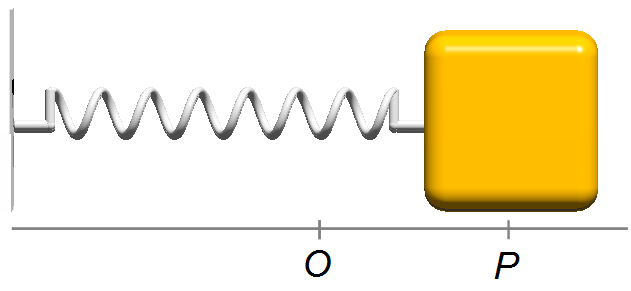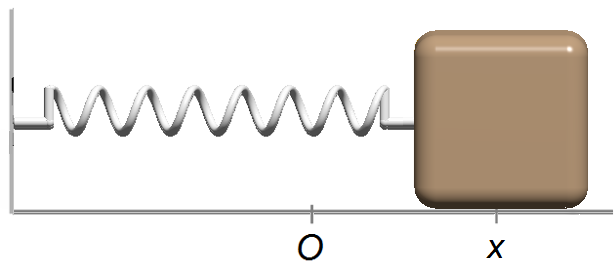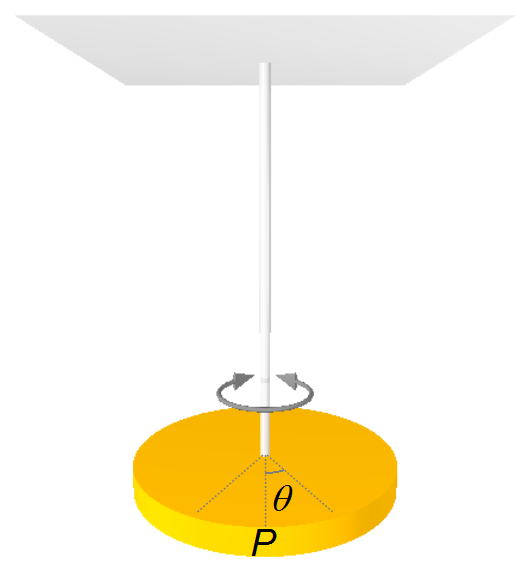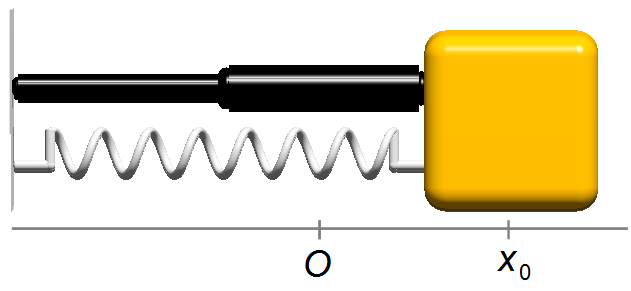Harmonic Oscillations
advertisement
Undamped Oscillator
A block of mass m is attached to a spring, the spring constant is equal to k. The block
is launched, from the equilibrium position O, with an initial velocity v0.
Determine:
a) The differential equation of motion;
b) The solution of the equation for the mass-spring system and the angular frequency of oscillations.
a) The differential equation of motion;
b) The solution of the equation for the mass-spring system and the angular frequency of oscillations.

A block of mass m = 0.25 kg is connected to a spring of constant k = 1 N/m. The block is
displaced from its equilibrium position O to a point P to 0.5 m and released from rest.
Determine:
a) Equation of displacement as a function of time;
b) The speed of the block;
c) Calculate the mechanical energy of the oscillator; d) The graph of position x as a function of time t.
a) Equation of displacement as a function of time;
b) The speed of the block;
c) Calculate the mechanical energy of the oscillator; d) The graph of position x as a function of time t.

A block of mass m is attached to the end of a spring, the spring constant is equal to k,
and placed on a horizontal frictionless surface. The other end of the spring is fixed at a point in the
wall. The block is displaced from its equilibrium position and released. Determine:
a) The equation of motion of the block;
b) The velocity as a function of the mass, m, the spring constant, k, the amplitude, A, and the distance, x, between the block and the point of equilibrium of the spring;
c) The magnitude of the maximum speed;
d) The acceleration as a function of the mass, m, the spring constant, k, and the distance, x, between the block and the point of equilibrium of the spring;
e) The magnitude of the maximum acceleration;
f) The kinetic energy;
g) The potential energy;
h) The total energy.
a) The equation of motion of the block;
b) The velocity as a function of the mass, m, the spring constant, k, the amplitude, A, and the distance, x, between the block and the point of equilibrium of the spring;
c) The magnitude of the maximum speed;
d) The acceleration as a function of the mass, m, the spring constant, k, and the distance, x, between the block and the point of equilibrium of the spring;
e) The magnitude of the maximum acceleration;
f) The kinetic energy;
g) The potential energy;
h) The total energy.

A body of mass m is suspended, by a wire of torsion constant κ, from the ceiling.
The body is displaced through an angle θ0 and released from rest. Determine:
a) The differential equation of motion;
b) The solution of the equation for the torsional pendulum and the angular frequency of oscillations;
c) The period of the oscillations.
a) The differential equation of motion;
b) The solution of the equation for the torsional pendulum and the angular frequency of oscillations;
c) The period of the oscillations.

A body of mass m is resting on a wooden support. The support starts to oscillate with simple harmonic
motion, increasing the frequency of oscillations until the body begins to slide over the wood.
a) Calculate the coefficient of friction between the body and the wood as a function of the period T and the amplitude A of the oscillations;
b) For period T = 3 s and amplitude A = 0.4 m, what is the coefficient of friction?
a) Calculate the coefficient of friction between the body and the wood as a function of the period T and the amplitude A of the oscillations;
b) For period T = 3 s and amplitude A = 0.4 m, what is the coefficient of friction?
Underdamped Oscillator
A block of mass m is attached to a spring, the spring constant is equal to k and a shock
absorber of damping coefficient b. The block is moved from its equilibrium position O to
a point x0 and released from rest. Using the damping force proportional to velocity,
determine:
a) The differential equation of motion;
b) The equation solution for the system in the case of underdamped oscillations and the angular frequency of the oscillations.
a) The differential equation of motion;
b) The equation solution for the system in the case of underdamped oscillations and the angular frequency of the oscillations.

A block of mass m = 2.50 kg is attached to a spring with a spring constant k = 12.00 N/m
and a shock absorber with a damping coefficient b = 0.60 N.s/m. The block is displaced from its
equilibrium position O to a point x0 at 0.20 m and released from rest.
Determine:
a) The equation of motion;
b) What is the type of oscillator?
c) The graph of position x versus time t.
a) The equation of motion;
b) What is the type of oscillator?
c) The graph of position x versus time t.

advertisement

Fisicaexe - Physics Solved Problems by Elcio Brandani Mondadori is licensed under a Creative Commons Attribution-NonCommercial-ShareAlike 4.0 International License .